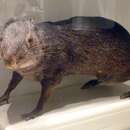en
names in breadcrumbs


This taxon is found in the Mesoamerican Gulf-Caribbean mangroves ecoregion, but not necessarily exclusive to this region.The Mesoamerican Gulf-Caribbean mangroves occupy a long expanse of disjunctive coastal zone along the Caribbean Sea and Gulf of Mexico for portions of Central America and Mexico. The ecoregion has a very high biodiversity and species richness of mammals, amphibians and reptiles. As with most mangrove systmems, the Mesoamerican Gulf-Caribbean ecoregion plays an important role in shoreline erosion prevention from Atlantic hurricanes and storms; in addition these mangroves are significant in their function as a nursery for coastal fishes, turtles and other marine organisms.
This disjunctive Neotropical ecoregion is comprised of elements lying along the Gulf of Mexico coastline of Mexico south of the Tampico area, and along the Caribbean Sea exposures of Belize, Honduras, Guatemala, Nicaragua, Costa Rica and Panama.There are 507 distinct vertebrate species that have been recorded in the Mesoamerican Gulf-Caribbean mangroves ecoregion.
Chief mangrove tree species found in the central portion of the ecoregion (e.g. Belize) are White Mangrove (Laguncularia racemosa), Red Mangrove (Rhizophora mangle), and Black Mangrove (Avicennia germinans); Buttonwood (Conocarpus erectus) is a related tree associate. Red mangrove tends to occupy the more seaward niches, while Black mangrove tends to dominate the more upland niches. Other plant associates occurring in this central part of the ecoregion are Swamp Caway (Pterocarpus officinalis), Provision Tree (Pachira auatica) and Marsh Fern (Acrostichum aureum).
The Mesoamerican Gulf-Caribbean mangroves ecoregion has a number of mammalian species, including: Mexican Agouti (Dasyprocta mexicana, CR); Mexican Black Howler Monkey (Alouatta pigra, EN); Baird's Tapir (Tapirus bairdii, EN); Central American Spider Monkey (Ateles geoffroyi, EN); Giant Anteater (Myrmecophaga tridactyla); Deppe's Squirrel (Sciurus deppei), who ranges from Tamaulipas, Mexico to the Atlantic versant of Costa Rica; Jaguar (Panthera onca, NT), which requires a large home range and hence would typically move between the mangroves and more upland moist forests; Margay (Leopardus wiedii, NT); Mantled Howler Monkey (Alouatta palliata); Mexican Big-eared Bat (Plecotus mexicanus, NT), a species found in the mangroves, but who mostly roosts in higher elevation caves; Central American Cacomistle (Bassariscus sumichrasti).
A number of reptiles have been recorded within the ecoregion including the Green Turtle (Chelonia mydas, EN); Hawksbill Sea Turtle (Eretmochelys imbricata, CR); Central American River Turtle (Dermatemys mawii, CR), distributed along the Atlantic drainages of southern Mexico to Guatemala; Morelets Crocodile (Crocodylus moreletii, LR/CD), a crocodile found along the mangroves of Yucatan, Belize and the Atlantic versant of Guatemala.
Some of the other reptiles found in this ecoregion are the Adorned Graceful Brown Snake (Rhadinaea decorata); Allen's Coral Snake (Micrurus alleni); Eyelash Palm Pitviper (Bothriechis schlegelii); False Fer-de-lance (Xenodon rabdocephalus); Blood Snake (Stenorrhina freminvillei); Bridled Anole (Anolis frenatus); Chocolate Anole (Anolis chocorum), found in Panamanian and Colombian lowland and mangrove subcoastal forests; Furrowed Wood Turtle (Rhinoclemmys areolata. NT); Brown Wood Turtle (LR/NT); Belize Leaf-toed Gecko (Phyllodactylus insularis), which occurs only in this ecoregion along with the Peten-Veracruz moist forests.
Salamanders found in this ecoregion are: Cukra Climbing Salamander (Bolitoglossa striatula); Rufescent Salamander (Bolitoglossa rufescens); Alta Verapaz Salamander (Bolitoglossa dofleini, NT), the largest tropical lungless salamander, whose coastal range spans Honduras, Guatemala and the Cayo District of Belize; Colombian Worm Salamander (Oedipina parvipes), which occurs from central Panama to Colombia; La Loma Salamander (Bolitoglossa colonnea), a limited range taxon occurring only in portions of Costa Rica and Panama;.Central American Worm Salamander (Oedipina elongata), who inhabits very moist habitats; Cienega Colorado Worm Salamander (Oedipina uniformis, NT), a limited range taxon found only in parts of Costa Rica and Panama, including higher elevation forests than the mangroves; Limon Worm Salamander (Oedipina alfaroi, VU), a restricted range caecilian found only on the Atlantic versant of Costa Rica and extreme northwest Panama. Caecilians found in the ecoregion are represented by: La Loma Caecilian (Dermophis parviceps), an organism found in the Atlantic versant of Panama and Costa Rica up to elevation 1200 metres